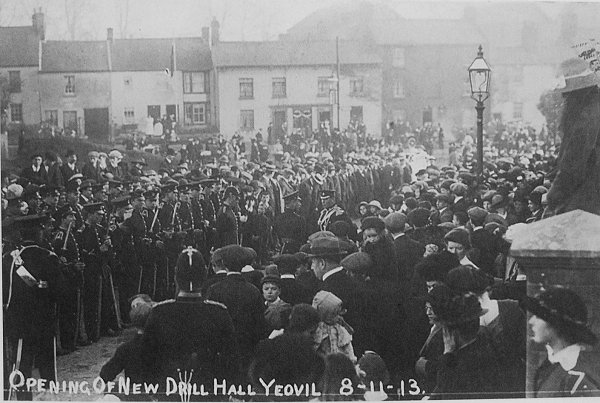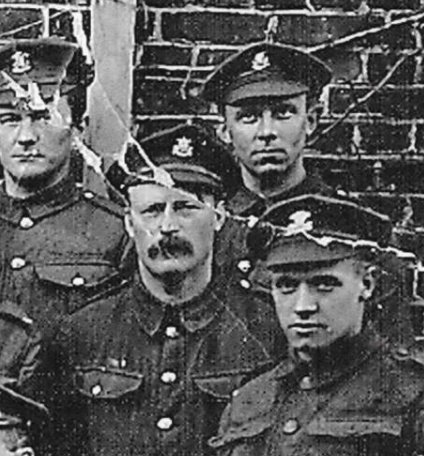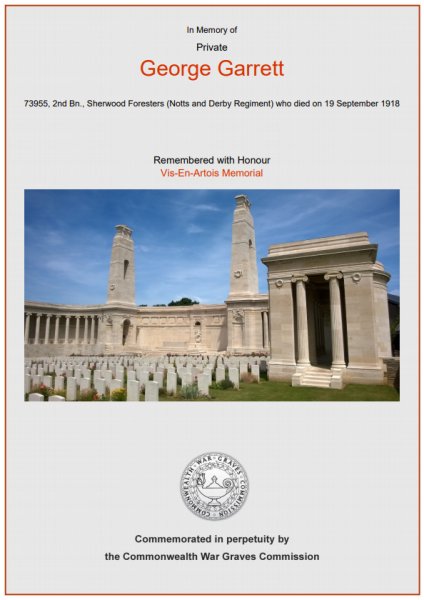yeovil at War
Henry George Garrett
Killed in action during the capture of the Quadrilateral
Henry George Garrett, known as George, was born in Yeovil on 29 June 1879. He was one of the six children of glove cutter Eli Garrett (b1841) and Mary Ann née Hambridge (b1842). The children, all Yeovil-born, were Melina (b1866), Alice (b1870), Lucy (b1872), Walter (b1876), George and Beatrice Louisa (b1884). In the 1881 census the family were listed at 70 Park Street at which time George was just one year old. The family were still at the same address in 1891, with the addition of 7-year old Beatrice.
On 23 February 1901 George married Alice Jane Hewlett (b1876) at Yeovil. They set up home at 2 Quidham Place (see Gallery), off Vicarage Street, and were listed there in the 1901 census in which George was noted as a glover. George and Alice were to have six children, although only three survived infancy; Linda (b1903), Frederick Walter (b1909) and Gwendoline (b1910). The 1911 census listed the family at 3 Quidham Place and George gave his occupation as a house painter.
 On
9 December 1915,
George enlisted
at the
Drill Hall
in Southville
and was placed on
the Army Reserve
List.
On
9 December 1915,
George enlisted
at the
Drill Hall
in Southville
and was placed on
the Army Reserve
List.
George was mobilized on 22 June 1916 and posted to the Devon Regiment. He was sent to France on 9 July 1916 then transferred to the 3rd (Special Reserve) Battalion, Somerset Light Infantry on 1 September 1916 with the Service Number 27343. The 3rd Battalion was a training battalion in which troops underwent training before being transferred to a front line unit.
He was again transferred, into the Welsh Regiment, on 29 June 1917, with the new Service Number 55453. On 27 February 1918 he was posted to No 1 Entrenching Battalion which, along with all other entrenching battalions, had been formed early in 1918.
On 1 April 1918 he was posted to 2nd Battalion, Sherwood Foresters (Notts & Derby Regiment), with the new Service Number 73955. A photo of George Garrett with three comrades of the Welsh Regiment is featured in the Gallery below (cropped image at left). This photograph would have been taken around the time George was transferred from the Welsh Regiment to the Sherwood Foresters - George, with the moustache, has a cap badge of the Sherwood Foresters while his comrades all retain their Welsh Regiment cap badges.
Although we cannot be certain exactly which fighting George took part in, certainly when he was posted to the Sherwood Foresters on 1 April 1918, he was almost immediately embroiled in the Battle of Bailleul (13-15 April 1918) when the Germans drove forward in the centre, taking Bailleul, 12 kilometres (7.5 mi) west of Armentières, despite increasing British resistance. This was immediately followed by the First Battle of Kemmel (17–19 April 1918). The Kemmelberg is a height commanding the area between Armentières and Ypres (see Gallery). On 17–19 April, the German Fourth Army attacked and was repulsed by the British.
George was on home leave from 20 August 1918 to 2 September 1918. The 2nd Battalion left St Omer on 2 September and, proceeding by train and route march, reached Monchy-la-Gache on the night of 14 September. The next two days were spent in training and then, on 17 September, orders were received - "The 71st Infantry Brigade will attack with the 2nd Sherwood Foresters and the 9th Norfolk Regiment; the 1st Leicestershire Regiment will be in reserve. The 2nd Sherwood Foresters will take the Green Line, the 9th Norfolks the Red Line. Both objectives will be consolidated in depth. Half a battalion of the 1st West Yorks is moving forward one hour before zero to a position in Trout Copse, and one company is at the call of the 2nd Sherwood Foresters to fill a gap between their right and the French left. The French regiment on our right is the 59th. The Battalion will commence the attack on a 850 yards front, and on reaching its objective will be occupying a front of 1,600 yards."
Unfortunately the operations of 17 September 1918, which were to have "made good the jumping-off line" for the next day's attack, were only partially successful, the French assault failing, while Holnon village, through which the line was to have passed, was only partly cleared of the enemy. Standing on the east edge of Holnon Wood, a bare glacis-slope devoid of cover, except for two or three shell-trap copses, stretched away for 3,000 yards to the high ground overlooking St. Quentin. There was no sign of life and very few trenches could be seen. It was later found that the Germans had camouflaged their trenches with thistles, covering the ground to a height of eighteen inches. At the highest point, about the centre of the Divisional area of attack, was a network of trenches known later as the Quadrilateral, which could be reinforced under cover from the back slopes of the hill. The position was one of great natural strength. Adequate time could not be given to brigades for reconnaissance and the troops had not seen the ground they had to attack over, and rain and smoke obscured the few landmarks existing on 18 September.
The Division attacked at 5.20am with the 71st Infantry Brigade on the right, its left directed on the Quadrilateral and it's right on Holnon and Selencey. The 16th Infantry Brigade was on the left, with its right just clear of the Quadrilateral and its left on Fresnoy-le-Petit. Six tanks were allotted to the Division, but met with various mishaps or were knocked out, and were not of much use. The attack was met with most determined opposition at once, especially on the right, where the difficulties of the 71st Brigade were increased by the failure of the French to take Round and Manchester Hills.
According to regimental sources, the 2nd Sherwood Foresters moved up to the position of readiness on the afternoon of of the 17th, and were in the assembly position by 3.15 next morning, advancing to attack at 5.25. Some 40 German prisoners were at once captured, but it soon became evident that the enemy was in great strength, that his machine guns were very numerous and well disposed, and that his wire was unusually thick and but little damaged by our artillery. At 7.45 the right company of the battalion was reported held up by heavy machine-gun fire, but the remaining companies pushed on, and soon after 8am the right company, with the 1st Buffs and 2nd Durham Light Infantry of the 16th Brigade, was reported as holding Douai trench with its left in touch with the 2nd York & Lancaster Regiment. There was now a long pause in the battle.
Between 10 and 12 o'clock pm news came to hand that the attack by the French had broken down, and that British attacks upon Holnon village had failed owing to the heavy fire from the German machine guns. Orders from the Brigade about midday on the 18th directed the attack upon the Quadrilateral to be renewed by the 2nd Foresters and the 9th Norfolks; but these orders were cancelled during the night of the 18th-19th, no doubt owing to the weakness of these battalions by reason of the losses they had sustained, and these were now ordered to withdraw to a position in rear between the Badger and Kirchner Copses, while other battalions took their place.
George Garret was reported missing in action, presumably on 18 September 1918, but was officially declared killed in action on 19 September. He was 38 years old. 2nd Battalion casualties were 4 officers and 56 other ranks killed, 6 officers and 267 NCOs and other ranks wounded and 37 men missing.
George Garrett is commemorated on the Vis-en-Artois Memorial, but his name is not inscribed on the War Memorial in the Borough despite being on my list for inclusion.
gallery

Quidham Place photographed in 1931. At the end of this narrow alleyway the court opened out slightly, to the left in the photograph. George and Alice brought up their young family here.

This photograph shows the ceremony of opening the new Drill Hall in Southville on 8 November 1913 photographed from Southville looking across to Reckleford. Just two years later, George would enlist at the Drill Hall.

Courtesy of
Sandra Andrews
A photo of George Garrett with three comrades of the Welsh Regiment. This photograph would have been taken around the time George was transferred from the Welsh Regiment to the Sherwood Foresters - George, with the moustache, has a cap badge of the Sherwood Foresters while his comrades all retain their Welsh Regiment cap badges.

The Commonwealth War Graves Commission certificate in memory of George Garrett.